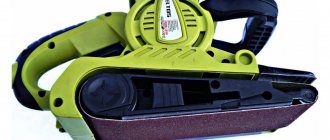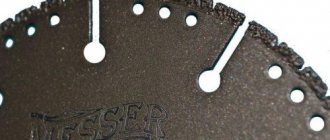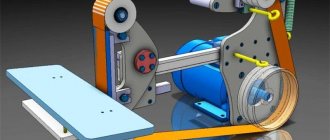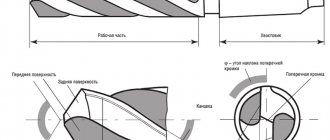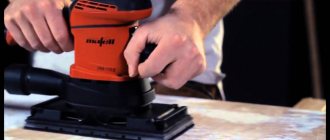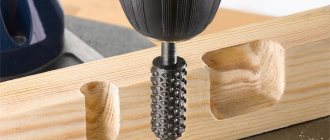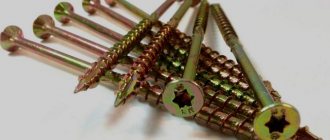Hand-held power tools for abrasive processing of surfaces of products and building structures are collectively called a grinding machine, or grinder. The terms are firmly established in everyday life, although this category also includes devices that perform cutting work, finishing polishing and cleaning surfaces from rust and old paint. Most sanders are electric, although pneumatic tools are also used in industrial production.
There are five main types of grinding machines, which differ from each other in the movement of the abrasive material and the design of the working body. Four of them are designed for polishing, grinding and other similar work, and one can also work with cutting wheels. All these tools are presented in specialized stores in a large assortment and a wide range of prices. At the same time, the answer to the question of how to choose a suitable grinding machine from such a variety will always sound approximately the same: first of all, you need to determine your needs, and then understand the purpose of the machine and the principles of operation. Images of the main types of hand-held power tools are presented in the figure below (delta refers to vibrating machines), and a brief description of each of them will be given below.
Types of sanders
There are six types of grinders, differing in the stroke of the grinding material and configuration:
- Circular;
- Longitudinal;
- Rotational, reciprocating.
Manufacturers produce tools that work both from the mains and with a battery.
Angle Grinder
An angle grinder, or popularly “grinder”, has an axis to which a cutting or grinding disc is attached, located at ninety degrees in relation to the electric drive rod.
- It is also used for grinding metal products, seams after welding, and removing the previous layer.
- For these purposes, a variety of attachments are used - felt sanding discs, flap brushes.
- Angler grinders are most often used for grinding metal, due to the high rotation speed of the electric motor (over ten thousand revolutions per minute).
It is possible to work with such indicators only by rough grinding of surfaces; it will not be possible to do better work at such speeds, especially on soft materials. The “grinder” has one significant disadvantage - the lack of proper dust removal.
Types of grinding machines
The main area of application of hand-held sanders is the processing of flat and curved surfaces of metal, wood, stone and plastic products with an abrasive tool. As a rule, such a grinding material is sandpaper based on fabric or paper, which moves at high speed along the surface being processed. Depending on what type of grinder it is, these movements can be longitudinal, circular, reciprocating and rotational. In addition to models connected to a 220 V network, many brands offer machines with autonomous battery power. The performance of such a grinding power tool depends on the power of the electric drive, as well as on the area of the abrasive in contact with the processing plane.
The standard speed of movement of the sandpaper depends on the type of material being sanded and in general follows a simple rule: the harder, the faster. Therefore, one of the most important technical characteristics of these devices, regardless of their type, is the ability to control the grinding speed. For this purpose, grinding machines are produced with adjustable motor speed, on which the linear speed of the sandpaper directly depends.
Another useful feature is the electronic stabilizer, which maintains a constant speed under load. Such options increase the price of the machine, but using them is much more convenient.
Corner
A manual angle grinder is popularly called a “grinder” or simply an angle grinder. This power tool has a spindle, on which cutting or grinding wheels are attached, located at an angle of 90º to the axis of the electric drive. In addition to cutting work, angle grinders are designed for rough grinding of metal, welds and removal of old coatings. Various flap wheels and brushes are available for this sanding machine, as well as felt and fiber sanding wheels. The main purpose of angle grinders is to work on metal, so they all have a high motor speed (usually more than 10,000 rpm). With such parameters, even if the speed is adjusted, it is impossible to qualitatively grind soft materials - only to strip and remove old coatings.
One of the main disadvantages of these sanders is the lack of a dust removal system.
Tape
This type of grinding machine gets its name from the tool used in them - a continuous abrasive sanding belt stretched over two rollers, one of which is the leading one.
The rollers have a small diameter, so the working part of the sanding belt is slightly less than half the length of its circumference. Belt grinders have a high linear speed of movement of the abrasive belt and high productivity. Therefore, they are most often used when preparing products for fine grinding or coating with paints and varnishes. In addition to processing metal and wood, such machines are used in construction work to remove old paint and rust, as well as leveling primed and putty surfaces. All belt sanders have an internal dust extraction system and the ability to connect an external vacuum cleaner.
One of the interesting features of this tool is the ability, provided by the design, to secure the machine on a workbench with the sanding belt facing upwards.
For this purpose, it is provided with protrusions or holes, and some manufacturers include special clamps in the delivery package. In this version, this grinder can be used as a mini-grinder for sharpening hand tools, drills and knives.
Vibrating
Vibratory sanders are also called surface sanders.
In this power tool, the working body is a flat rectangle (sole, platform), which, using an eccentric mechanism, makes reciprocating movements along the surface of the material being sanded. In this type of sander, rectangular sheets of sanding paper are used as a working tool, which are fixed to the elastic base of the sole using clamps or a sticky surface. The vibration frequency of the sole in such machines reaches 10–12 thousand per second, and the amplitude is 1–2 millimeters. Surface grinders are used for finishing grinding of various materials, and their performance directly depends on the area of the base, as well as the frequency and amplitude of its movements. The design feature of vibrating sanders does not allow them to process joints and corners, so for such purposes they use a variety of them - delta sanders. The working surface of this power grinding tool is made in the shape of a triangle with an acute angle extended forward, which makes it possible to process mating surfaces without dead zones. Delta sanders are mainly designed for working in hard-to-reach places after the main grinding, which is why many models are available in a cordless version.
Eccentric (orbital)
Orbital sanders have a round working base.
During grinding, it simultaneously rotates and performs reciprocating movements. This occurs due to the use of an orbital mechanism with two shafts in the machine drive. The first shaft is the axis of the sanding pad disk and is shifted relative to its geometric center by several millimeters (i.e., it is located eccentrically), therefore, turning around it, the disk makes circular reciprocating movements. And the rotation of the disk is transmitted through the second shaft, which passes through the geometric center of the circle and, in the process of movement, runs around the axial shaft in a circular orbit. Orbital sanders allow you to obtain the highest quality sanding and even polish paint coatings. Therefore, in furniture, restoration and auto repair shops, eccentric sanders are used for finishing and polishing, and other types are used for cleaning and pre-grinding. The performance and quality of surfaces during orbital grinding depends on the area of the base, the rotation speed and the amplitude of vibration of the disc. The lower the last indicator, the higher the quality and the lower the productivity. For most orbital sanders, it is fixed and ranges from two to five millimeters, but there are models with the ability to adjust this parameter.
Brush
There are two main layouts of brush sanders: similar to angular sanders and similar to belt sanders.
In the first case, the axis of rotation of the abrasive tool is also at right angles to the axis of the electric drive, and the electric motor is located in an elongated handle. The main difference between such a tool and an angle grinder is the low rotation speed and a different location of the guide handle. In the second case, the grinding machine has the same rectangular body, but only one roller, which is driven and has a larger diameter than a belt grinder. As a working tool, brush grinders use rollers with long metal or plastic bristles, as well as brushes with sandpaper lamellas. In this version, machines are used to clean surfaces from oxides, rust and old coatings before finishing. In addition, these machines use round or conical mandrels for abrasive cloth or felt, which can be used for grinding and polishing.
An exclusive area of application for brush sanders is the creation of texture on wood, which is done with special nylon brushes.
Straight (end)
Straight sanders are the simplest type of hand sanders. They are designed for trimming, deburring and sanding small surfaces. Structurally, such a tool is an elongated body with an electric motor with a diameter the size of a hand, on the shaft of which there is a spindle with a collet chuck with an internal diameter of 3 to 8 mm. Cylindrical, conical and spherical sanding stones of small diameter, as well as flap and cutting wheels are used as abrasive tools for straight grinders. Due to the ability to process sandpaper with the end, these machines are sometimes called end-cut machines.
Belt sanding
The belt sander got its name from a solid abrasive sanding belt located on two shafts, one of which is the drive shaft.
This type of tool has a high belt speed and excellent productivity. Thanks to these qualities, the electric grinder is used for finishing work - fine grinding, before processing the product with paints and varnishes.
In addition, they are used during the construction stages to remove:
- Previous paint coating;
- Rusty coating;
- Excess on primed, plastered surfaces.
This type of sander is equipped with a closed dust extraction structure with the ability to connect a vacuum cleaner. In addition, on this model it is possible to install it upside down, so that the sanding belt can be aligned. To do this, the tool is secured using clamps included with the workbench. This function allows you to sharpen knives, bench tools, drills, using the grinder as a mini-grinder.
Vibrating
Another name that many people know is a surface grinder. It received its second name thanks to a flat rectangular platform, which, with the assistance of an eccentric electric mechanism, makes reciprocating moves over the entire surface of the product.
Sanding attachments include rectangular sandpaper sheets attached to the surface of the sole using special clips or Velcro. Grinding machines are used for finishing work on various products.
However, the design of the tool does not allow access to corners and joints during grinding; in this case, a delta grinder is used, which is one of the varieties of this group.
Here the working surface resembles a triangle with an acute angle protruding forward. This design perfectly allows you to get into hard-to-reach places, while doing the job efficiently. Since the delta grinder is not used so often, only when necessary, these models are often produced with a battery.
Angle grinder capabilities, discs for it
A grinder (angle grinder) can also be used for sanding wood. It can be used for rough processing.
This tool allows you to quickly clean wooden surfaces, in particular sand floors and walls. This universal device is capable of performing a variety of operations, with appropriate wheels for each: cutting, grinding and roughing (grinding).
A grinder can cut metal, stone, and wood. But it is not advisable to saw boards and other wood, otherwise the tool will overheat greatly. Wood saw blades for grinders resemble modern saw models, but different alloys are used for their manufacture. The only drawback of an angle grinder is the presence of various irregularities after work, which then take a long time to level out.
For grinding work, special red wheels are used. A good option is to use petal or disc wheels with a grain size suitable for each case.
Considering that the working plane is located under the protective casing, performing specific actions does not pose a danger to humans, which makes it possible to move the tool in any direction. The main thing is to be careful when working with surfaces that have protruding heads of screws and nails.
Note! To make it easier and faster to replace sandpaper, it is recommended to install an attachment with a sticky surface on the grinder.
Draw machine
In a belt sander for wood, the working element is represented by a belt fixed around two rollers. During their movement, the tape attached to the sole is brought into working condition and rotates at the required speed. It is the speed that is considered an important indicator of the operation of this device and it depends on the power, which can be in the range of 500-1200 W. There are tools equipped with an additional speed regulator, which allows you to select the most optimal option for each type of surface.
Belt sizes vary depending on the modification of the sanding machine. This indicator is the highest for the most functional device. At the same time, the weight and dimensions of the structure will also be significant. When choosing a power tool, special attention should be paid to the grain size of the tape used. For ease of work, it is necessary to have several types of tapes with different grain sizes. One type of belt sander for wood is a brush device that performs the roughest processing.
Orbital (eccentric) sander
According to the principle of operation, this device for processing wooden surfaces is similar to a VShM. The main distinguishing indicator is the higher productivity of the vibratory sander. In addition, processing is carried out more accurately and delicately thanks to the complex trajectory of the grinding element. The grinding is carried out with discs with a diameter of 15 cm. Abrasive circles of suitable grain size are molded onto them.
The disadvantage of an eccentric machine is the formation of excessive amounts of dust. But manufacturers supply models equipped with effective dust collectors, which allow work to be carried out in enclosed spaces.
Vibrating sander
The sole of a vibration-type technique can be triangular (iron) or rectangular. During processing, she performs circular movements with a small amplitude. The machine is used for those cases when it is necessary to obtain a high-quality surface, for example, to restore furniture before applying stain or varnish. Sanding is required especially carefully, since all flaws will be clearly visible through the transparent layer of the finishing coat. At the same time, the device has low performance.
Note! It is better to choose a rectangular sole for finishing large areas, and for corners and hard-to-reach places it is advisable to use a triangular shape.
When working with a vibrating grinder, it is imperative to remove debris, any solid substances, and grains of sand so that small circles - marks - do not form on the surface. To remove such defects, you will need an abrasive wheel with the finest grain size. The surface of the wood to be treated must be thoroughly cleaned with a vacuum cleaner.
Oscillating wood sander
This electric tool is a multi-functional resurfacer that is also capable of sanding wood surfaces. It differs from other tools in its budget price and very low power consumption. With its help you can process sharp corners and places near vertical walls. To carry out this manipulation, a special triangular platform is installed on the grinding machine, to which a grinding wheel on a self-adhesive base is attached. In addition, the device makes it possible to effectively clean the floor from glued linoleum and tiles, create slots, and cut communication lines.
During operation, the sole moves in a horizontal plane with minimal amplitude, the tops of the platform deviate by an average of 2.5 mm (1.7 degrees). Due to these movements, surface treatment is carried out. This device can be used for grinding corners and other hard-to-reach areas. The machine does an excellent job not only of removing wood, but also of smeared or dried glue. In general, the oscillating machine is used for finishing in places where other machines cannot cope due to their low productivity or sanding spot.
Orbital (eccentric) electric sander
The working platform of an eccentric grinder is a circle that rotates and makes reciprocating movements. An eccentric device with two rollers allows this to be done (hence the second name of the tool).
The first is the axis of the grinder disk, shifted relative to the center by a couple of millimeters.
- Self-rotation is carried out through another roll passing through the middle of the circle in a circle around the shaft.
- Using this type of sander, you can achieve excellent grinding quality; in addition, you can polish the surface of the product coated with varnish.
- It is because of this that they are valuable in furniture, restoration, car repair shops and other enterprises where the quality of polishing and grinding of products is important.
Brush grinder
There are two types of brush grinding, which are similar in appearance to angle grinders and belt grinding. In the first type, the axis of rotation is also located at an angle of 90 degrees with respect to the electric drive, which is located in the elongated handle.
This model differs from an angle grinder in that the brush model has a much lower rotation speed. Also, the handle is on a completely different side.
- The second model is equipped with the same rectangular platform, only there will be only one roller, which acts as a drive.
- Its diameter is significantly larger than that of belt grinding.
- The scope of use of these models is the removal of oxidation, rusty layer, and previous coating from the surface of products before proceeding with finishing.
In addition, these products use round or cone-shaped pads to which sandpaper or felt is fixed. Thanks to this, you can grind or polish the surface.
Types of grinders by application
According to their purpose, grinders are divided into angle, straight, belt, brush, eccentric, vibrating, delta grinders, polishing and oscillating.
Angle Grinder
An angle grinder, or grinder, is used for processing metal, stone, ceramic and concrete surfaces. The working shaft of such a machine is located at an angle to the plane of the electric motor. Using abrasive discs, angle grinders can be used to remove rust, cut ceramic tiles into pieces, and grind welds. Additional special attachments expand the scope of use of the grinder. When choosing such a tool, pay special attention to the length of the spindle and the weight of the unit.
Cutting wheel BOSCH for stone 115x22x2.5
Straight grinder
A grinding machine of this type is also called an engraver. An engraver is a multifunctional tool that can be used to perform work that requires high precision. A straight grinder consists of a housing, an electric motor, a gearbox with a spindle. Using such a machine, you can perform grinding, drilling, cutting, sanding, engraving and other types of work. The machine may come with various types of brushes, cutting wheels, grinding stones, etc. Direct type grinders have a compact size, which allows them to be used even in cramped conditions when work space is very limited.
Belt sander
This tool is used when rough grinding, surface roughing is required, or when it is necessary to remove a thick layer of a particular material. This type of machine is used in carpentry, carpentry, and construction. It is used to process materials such as plastic, wood, metal, etc. Grinding is carried out by moving the sanding belt along guide rollers. This tool is characterized by a particularly low center of gravity, which means that minimal effort is required when working with the draw frame. If you need a tool to level small surfaces, it is better to purchase a machine with a short belt.
Brush grinder
The peculiarity of this tool is that instead of sandpaper, a metal brush is used. Thanks to it, machines of this type make it possible to effectively process various surfaces: wood, metal, and glass. With this tool you can sand parquet and wooden floors, remove old paintwork, make the surface smooth, and structure wood.
Random orbital sander
Also called orbital. Its design includes an eccentric, which makes it possible to simultaneously perform both reciprocating and circular movements. Using an eccentric machine you can clean, grind and polish volumetric, profile and curved objects. Equipped with sheets of different grain sizes, orbital machines can work with a variety of surfaces, including plastic, wood and metal.
Orbital sanders come in two types: those equipped with a classic handle and those equipped with a single-palm handle. The former are designed for processing large surface areas, while the latter are used when delicate work is required.
Random sander BLACK&DECKER KA198-QS, 260 W, 125 mm
Vibration sander
A vibrating or surface grinding machine is also used for grinding wood, plastic, metal, stone, and composite materials. This tool is actively used in woodworking, body repair, and also in furniture repair. The vibrating grinder is driven by an electric motor, which transmits oscillatory motion to the sole through an eccentric connecting rod. Abrasive sheets are attached to the sole with clips or Velcro.
Orbital sander MATRIX EM-OS 180, 180 W, 90×187 mm
Delta sander
This is a type of sander similar to an oscillating sander. It differs in a different shape of the working element; in delta sanders it has the shape of a triangle. They use a delta sander to process the surface in hard-to-reach places: in recesses, on convexities, etc. The delta sander is easy to use, it is compact in size and has a low weight.
Polishing machine
This is the name of another type of grinder. The device is equipped with a D-shaped handle attached to the body. A distinctive feature of the device is that it operates at low speeds, which can be adjusted. This machine comes complete with several wheels: abrasive, felt, foam and fur. This machine is used for surface cleaning, sanding and polishing. It can be used where particularly delicate grinding is required.
Oscillating machines
The peculiarity of such machines is the triangular sole, moving with a small amplitude - from 1 to 3 mm. The sole has holes for removing dust. Abrasive sheets are attached to it using Velcro. This machine is intended for cutting, polishing and cleaning various surfaces, as well as making holes in chipboard and gypsum board.
Crosscut, straight model
They are the simplest of this category of tools. Used for minor work - trimming, stripping, sanding. In appearance it is an elongated body with an electric motor.
In this case, the working element is sanding attachments in the form of a cylinder, cone, or sphere of not very large shape. Both cutting and flap discs can also be used.
How does a household appliance differ from a professional one?
There are several main differences that are undoubtedly worth paying attention to when choosing a tool:
- Working hours. The household tool can be used without stopping for five to ten minutes, after which the machine should be allowed to cool for some time. A professional model can work from fifteen to twenty minutes, and she needs literally five minutes to rest.
- Terms of use, level of protection. It is immediately clear that a more serious instrument (professional) will look better in relation to the “amateur” one. It will better “swallow” dust and moisture, and “steadfastly” withstand wire breakdowns and long-term operation.
- Durability. For a household tool, it will be enough to work for two to three hours a day and that’s it, but a professional tool can withstand two full-fledged work shifts.
In addition, a professional tool has additional “bells and whistles,” but a household model may have them, but only a top-tier tool. It is clear that the manufacture of serious power tools requires high-quality materials and excellent fittings.
And they are several times more expensive compared to household ones. Most well-known manufacturers make it easier for their customers to choose by releasing instruments on store shelves where the body is made in different colors. For example, Bosh, blue is professional, green is amateur.
Decisive factors when choosing
Before you start choosing a grinding machine, you should decide what it will be used for and under what conditions it will be used.
Not only its technical characteristics will depend on this, but also the price, as well as the cost of consumables and possible repairs. For example, if you just need to clear the old paint from the floors in your dacha and tidy up the porch before painting, then a belt sander costing several thousand rubles with more or less good reviews will be quite suitable. If the machine is chosen for a home workshop, in which it is planned to make furniture and interior items, then, most likely, you will have to choose a decent orbital sander with good performance and speed control. But regardless of what type of machine you plan to purchase, when choosing it you need to pay attention to a number of important factors:
- Abrasive speed. It must match the type of material being processed, or the machine must have a speed controller.
- Consumption and cost of abrasive and operating materials. For example, one of the problems with some branded models is the difficulty in purchasing and the high price of sole pads.
- The need for autonomous battery power.
- Ergonomics, including additional handles.
- Availability of a standard pipe for a vacuum cleaner or adapters.
- Noise and vibration levels. These characteristics can only be found out from user reviews.
- Guarantee period. It can range from one year to five years and is subject to mandatory periodic maintenance at company centers.
In addition, you should definitely pay attention to the cost of delivery and the proximity of warranty workshops.
Some people buy grinding machines for several thousand rubles on the principle: “if it breaks, I’ll throw it away and buy a new one.” Others, even for one-time work, prefer to purchase advanced models costing more than ten thousand rubles. What position do you take? Please write about this in your comments to this article.
What you should pay attention to
Before you go to the store to buy something, you should think again about where and what it will be used for.
After all, not only the price range will depend on this, but also the additional materials that will need to be purchased:
- If a sander is needed to remove old paint from a wooden floor in a country house, then in this case ordinary belt sanding will be sufficient. Moreover, its cost will not be very high, about several thousand, but it should have good reviews.
- If you are purchasing a tool for a home workshop, where carpentry work will be carried out on the manufacture of furniture and interior items, then you should think about buying a good orbital sander with excellent performance and speed.
However, no matter what tool you plan to purchase, it is worth considering the following indicators, which are relevant for all types of grinders:
- Speed of surface movement;
- Availability of speed control;
- How often will the abrasive material need to be changed?
- Availability of additional devices on the market;
- Equipped with spare batteries, handles;
- Possibility of connecting a vacuum cleaner, adapter;
- Noise level, vibration;
- Warranty, service.
In addition, you can find out how far the warranty workshops are from your place of residence, as well as how much the delivery of the purchased product will cost.
So you can choose any tool, the most important thing is that it works properly, is in demand, and is easy to maintain. You should not avoid reviews from real customers, as you can glean a lot of useful information from them that you would never get from the seller.
General criteria for choosing a grinding machine
When purchasing a grinding machine, pay attention to:
- Power is the most important characteristic of a tool. The more power, the higher the performance. But powerful machines waste electricity. In addition, they are quite heavy. If the machine is needed for domestic purposes, then a 600 W tool will be sufficient. If, with the help of such equipment, you need to solve the problem of processing metal, concrete or combined complex surfaces, then it is better to opt for a model whose power is about 3000 W.
- Rotation speed - manufacturers indicate this parameter when the machine is idling. The efficiency of the tool with different metals also depends on the rotation speed. To process hard materials, high engine speeds are needed, while soft materials are processed at low speeds. Please note that to operate a high-speed sander, the operator must have certain skills and qualifications. The fact is that at high speeds the grinder increases its forward movement, so it needs to be moved faster over the surface being processed.
- Equipment parameters - the depth of cut depends on them, as well as the area covered when processing the surface. Grinders can be equipped with abrasive discs of the following sizes: small, the diameter of which does not exceed 150 mm, medium - from 150 to 200 mm, large - from 250 and above.
- Weight is a fairly important indicator, on which the convenience of work largely depends. There are light grinders weighing about 2-3 kg. But there are also heavy units, the weight of which reaches 6 kg. Correctly assess your strengths when choosing an instrument. If it is powerful but too heavy, it will hardly allow you to work comfortably.
- The presence of a soft start function - this option makes it possible to control the parameters of the electric motor and keep their value in a safe range. A smooth start allows for more accurate sanding.
- Cord length - choose the model that has the maximum length. In this case, you do not have to use an extension cord.
In addition, the tool must be able to adjust the speed if you want to achieve maximum efficiency from its use. For comfortable and safe work with the grinder, the selected model must have a system of protective functions, which include: locking the power button, protecting the device from overheating, blocking equipment jamming, and vibration protection. For comfortable work, it is desirable that the handles of the grinder have rubber pads. With them, the tool will not slip out of your hands.
